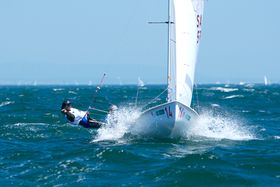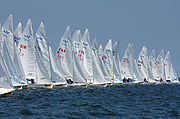470 (dinghy)
| Current Specifications | |
|---|---|
 |
|
 Class Symbol |
|
| Crew | 2 (single trapeze) |
| LOA | 4,700 mm (15 ft 5 in) |
| LWL | 4,400 mm (14 ft 5 in) |
| Beam | 1,690 mm (5 ft 7 in) |
| Draft | 500 mm (1 ft 8 in) 1,066 mm (3 ft 6 in) |
| Hull weight | 120 kg (260 lb) |
| Mainsail area | 9.12 m2 (98.2 sq ft) |
| Jib / Genoa area | 3.58 m2 (38.5 sq ft) |
| Spinnaker area | 13 m2 (140 sq ft) |
| Olympic Class | |
The 470 (Four-Seventy) is a double-handed monohull planing dinghy with a centreboard, Bermuda rig, and center sheeting.
The name is the overall length of the boat in centimeters (i.e., the boat is 4.70 meters long). The 470 has been an Olympic class since the 1976 games. The Class was initially an open class, but since the 1988 games there have been separate events for men and women. The hull is fiberglass with integral buoyancy tanks.
It is a popular class of dinghy with both individuals and sailing schools, offering a good introduction to high-performance boats without being excessively difficult to handle. It is not a boat designed for beginners. It has a large sail-area-to-weight ratio, and is designed to plane easily.
Most sailors get substantial experience in a more stable and less demanding dinghy before beginning the 470.
The 470 is equipped with spinnaker and trapeze, making teamwork necessary to sail it well. The 470 is not difficult, but to be competitive everything should be mastered to perfection. Tactically the boat is demanding because speed differences are small and fleets are usually big.
Contents |
History
The 470 was designed in 1963 by the Frenchman André Cornu as a modern fiberglass planing dinghy to appeal to sailors of different sizes and ages. This formula succeeded, and the boat spread around the world. In 1969, the class was given international status and it has been an Olympic class since 1976. In 1988, the first Olympic women's sailing event used the 470.
The Olympics and the 470

The Olympic regatta is not unlike other events in the Olympic Games in that it is the culmination of years of training and competition for an athlete. What differs is that the racing takes place over multiple days, so the sailor has to prepare for what is sure to be a long, demanding event.
Beyond the Games, the Olympic circuit comprises a series of 'Graded' events in known locations, similar to World Cup races in Olympic skiing, for example. These events are annual and are supplemented by continental and World championships that are hosted in different locations each year. In short, the competition schedule for an Olympic fleet is not merely during the Olympic year, but rather, runs continuously during the quadrennial Games.
The Sailor
To sail the 470, good physical health is enough; strength is not crucial, while world class 470's sailors spend a large portion of their time on fitness. The competitive crew weight is 110 - 145 kg, making it ideal for both women and men.
Races

World and Continental Championships are organized every year with separate starts for women and men/mixed teams. There is also a World Championship for juniors and a Master World Championship. The 470 is used in regional championships such as the Asian, Mediterranean, and PanAm Games. Entries are limited in important international races, encouraging more competition by requiring qualifying races in most countries.
In the World Championships more than 30 countries have been represented. There are 65 member nations in the International Class Association and more than 40,000 boats have been built in 20 countries on all continents.
Construction
As a strict one-design class, the 470 is required to be built by a licensed builder. Class rules require that construction use materials of the 1960's era, most notably glass reinforced polyester for much of the hull. [1]
Additional Specifications.[2]
- Mast height: 6.78 m (22 ft 3 in)
- Boom length: 2.65 m (8 ft 8 1⁄2 in)
- Spinnaker Pole length: 1.90 m (6 ft 3 in)
References
- ↑ 470 Class Rules, available at http://www.sailing.org/1893.php
- ↑ 470 Class Homepage, http://www.470.org/The-470-Class-Dinghy
External links
|
|||||||||||
|
|||||||||||
|
|||||
|
||||||||||||||
